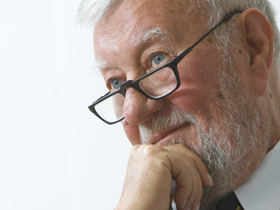

Copyright © 2011 Kanda Gaigo Alumni Association(KGAA). All rights reserved.
50th Anniversary -Interviews-

When I came to Japan in 1986, English language teaching in Japan was very poor. Professor Ogawa, the first president of KUIS, took me to the best universities in Tokyo. But there the students were sitting in language laboratories, repeating words and sentences like automatons, or robots. Mr. Ogawa asked me "Can you do better than that? " I said "Yes, that's easy."

I was a professor of English in the Department of English at the beginning of KUIS. After two years of establishment, Mr. Ryuji Sano, who had become of Chairman of the Sano Foundation, asked me to start the ELI, the English Language Institute. I sail "YES!" to his offer. It was a great opportunity for me. When I was studying at Columbia University, I became interested in Learner Autonomy and have been researching the concept since then. I thought that the ELI, an independent institution, would give me an opportunity to write a curriculum based on learner autonomy in language education. Mr. Sano also wanted to put the theory into practice to make KUIS different. Mr. Sano said "Stay in Japan. We are the same age. You stay while I am here." So the project of the ELI started in 1989 and I stayed at KUIS.
At first, I started to hire teachers of the ELI. I wanted to find young and good teachers from around the world. ELI teachers had to be people who had just graduated with in an MA in Applied Linguistics. Some of these were 23 years old and some of our students were up to 22 years old. They were almost same age, so they can communicate with the subjects of arts, music, sports and social events. I don't know Rock Stars and am not very interested in them. But the ELI then was based upon the need for these young teachers to meet and communicate with young students. They would do that better than I could.
People who had just graduated with in an MA were all very keen to come and to start their professional career. I went to New York, London, South Africa, Singapore, Australia, New Zealand... We advertised every year all over the world, and we went to interview the good applicants. We always went personally to see those people we want to employ. We wanted to be sure they would teach our students well.

I had a reason my travel around the world getting teachers for the ELI. Many schools and universities in Japan say "I want to have American English teachers." But students of KUIS must understand and use English in a whole variety of forms, not only American English, but British English, Australian English, Canadian English, and Singaporean English, and many other Englishes. I joke that we always employ some Scots to prove to our students how difficult they are to understand! We native English speakers can't understand them, either. So that was part of the ELI's job to make communication, across differing forms of English understandable.
The members of the ELI, the teachers, had a different kind of contract. They have a teaching component in their contract and then they have a research component. And the research component is to develop the curriculum of ELI English Proficiency classes. To bring different nationalities, different ways of speaking English, different backgrounds. Our teachers come from different educational backgrounds, and have different ideas about how to teach, and we bring them together, and then negotiate to work out a common curriculum. At this university, the curriculum of the ELI is always changing ---- it will never be finished.
Mr. Sano supports research development in the ELI. If you go to a conference like JALT, more papers have been given by KUIS teachers than any other university in Japan. Why? It is because of our research. Because Mr. Sano supports our research and enables teachers to go overseas to present our research at conferences overseas. If they are presenting on what they do at Kanda, this advertises Kanda overseas. Mr. Sano knows supporting teachers' research was an investment.
As KUIS got good reputation in the world, we got applications from many important institutions from people who had just graduated in the MA programs. When the ELI started, I just asked a few of my friends. Now there are 65 ELI teachers. We now have two hundred or three hundred applicants each year for jobs coming into the ELI from all over the world.
Every time I went to see Mr. Sano, it seemed that I was asking for more money for the ELI. But he said to me "That's OK. You are not asking for yourself. You are asking for our students."(3/6)
Contact: Kimiyo WATANAE
PR department / Sano Educational Foundation
Telephone: +81-33258-5837
http://www.kandagaigo.ac.jp/
Photographer: Hideki SHIOZAWA
http://www.shiozawahideki.com/